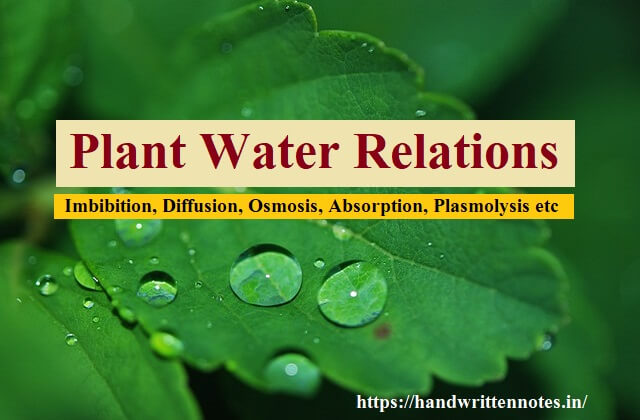Plant Water Relations are the study of the behaviour of water with plants. Imbibition, Diffusion, Osmosis, Absorption, Plasmolysis, Deplasmolysis, Ascent of sap, Wilting, Transpiration, Translocation, Permeability, Turgor Pressure and Wall Pressure are important terms or processes in which water is the main component.
1.Plant Water Relations: Imbibition
Imbibition is the process of adsorption of water by hydrophilic surfaces of a substance without forming a solution. It is actually a type of diffusion in which movement of water takes place along a diffusion gradient. The solid particles Which adsorbed water are called imbibants.
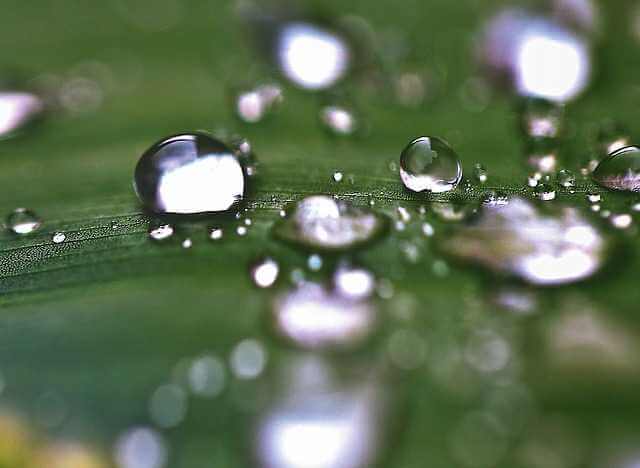
During the process of imbibition, imbibants increase in volume. Some scientists have been observed that there is an actual compression of water.
Imbibition process produces heat because the kinetic energy of absorbed water molecules is released in the form of heat.
Imbibition pressure also developed during the process because it exits due to the presence of hydrophilic substances in the cell which include organic colloids and cell wall.
Factors Influencing The Rate of Imbibition
2. Plant Water Relations: Diffusion
Diffusion is the process of movement of the molecules of solids, liquids and gases from the region of higher concentration to the region of lower concentration.
It may occur between 1. Gas & Gas, 2. Liquid and liquid 3. Solid and liquid
Release of ammonia gas into the air is an example of diffusion of Gas & Gas. When alcohol mixed with water is an example of Liquid and liquid types of diffusion. When we dissolved sugar into water, this is the example of Solid and liquid type of diffusion.
Diffusion occurs due to diffusion pressure. Diffusion pressure is the potential ability of the molecules or ions of any substance to diffuse from an area of their higher concentration to that of their lower concentration.
Factors influencing the rate of Diffusion
Diffusion is very important to perform Gaseous exchange, transpiration, translocation etc biological activities.
Read Also – Plant Diseases: Symptoms, Types, Controls | DC
3. Plant Water Relations: Permeability
The degree of diffusion of gases, liquids and dissolved substances through a membrane is called the permeability of that membrane. Different types of membranes are differentially permeable.
Types of membranes
- Permeable membranes: Allow free passes of solvent and most of the dissolved substances.
- Impermeable membrane: Do not allow the entry of water, dissolved substances and gases.
- Semipermeable membrane: the movement of solvent molecules only through them but prevent the movement of solute particles.
- Selectively permeable membrane: It is also called the differentially permeable membrane because this type of membranes allows selective passage of solutes along with solvent through them.
4. Plant Water Relations: Osmosis
Osmosis was discovered in 1748 by Abbe Nollet. Osmosis is a special type of diffusion of liquid in which solvent moves through a semipermeable membrane from a place of higher pressure to the place of lower pressure.
In easy words, we can define Osmosis as the movement of water from its higher concentration to the lower concentration is called osmosis.
Another definition of osmosis is that it is the Migration of solvent from a hypotonic solution to hypertonic solution through semipermeable membrane to keep the concentration equal.
Types of Osmosis
- Endosmosis: The flow of water into a cell when it is placed in a solution whose solute concentration is less than that cell sap.
- Exosmosis: The outflow of water from a cell when it is placed in a solution whose solute concentration is more than that of cell sap
Osmotic Concentrations
- Hypotonic solution: A solution whose osmotic concentration is less than that of cell sap or another solution.
- Hypotonic solution: A solution whose concentration is more than that of cell sap or another solution.
- Isotonic solution: It is equal to that of another solution or cell sap.
Importance of Osmosis
5. Plant Water Relations: Plasmolysis
Plasmolysis is the shrinkage of the protoplast of a living cell from its cell wall due to exosmosis under the influence of a hypotonic solution.

Types of plasmolysis
- Incipient plasmolysis: It is the stage of plasmolysis when the protoplast just begins to contract away from the cell wall.
- Evident plasmolysis: It is the stage when the cell wall has reached its limit of contraction and the protoplast has detached from the cell wall.
Importance of Plasmolysis
6. Plant Water Relations: Deplasmolysis
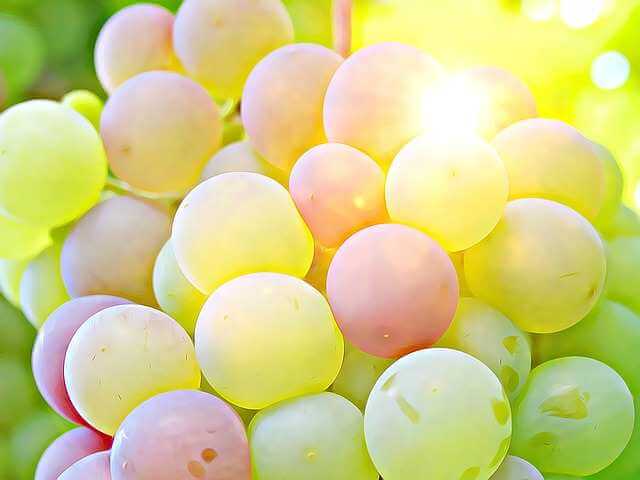
Deplasmolysis is the swelling up of a plasmolysed protoplast due to and Osmosis under the influence of a hypertonic solution or water. Deplasmolysis is possible only immediately after plasmolysis otherwise, the cell protoplast get permanently damaged because of plasmolysis process.
The value of turgor pressure becomes zero at the time of limiting plasmolysis and below zero during incipient and evident plasmolysis.
Example: Tradescantia leaf is used for demonstration of Plasmolysis and Deplasmolysis.
7. Plant Water Relations: Wilting

Wilting is a condition when a plant usually fails to survive due to water deficiency. Due to scarcity of water, the symptoms appear in the plants, plant parts or in the cells of plants. Turgidity gets lost so that folding and dropping of leaves and other soft aerial parts of the plan occurs.
Types of Wilting
- Incipient Wilting: Mesophyll cells loss a part of their water content during midday due to transpiration.
- Temporary wilting: It occurs during midday and it is visible externally due to dropping of leaves and young shoots. the rate of transpiration is quite high as compared to water absorption in the night.
- Permanent wilting: It is the last stage of wilting in which the aerial parts do not regain turgidity even if placed in a water-saturated atmosphere.
8. Absorption of Water
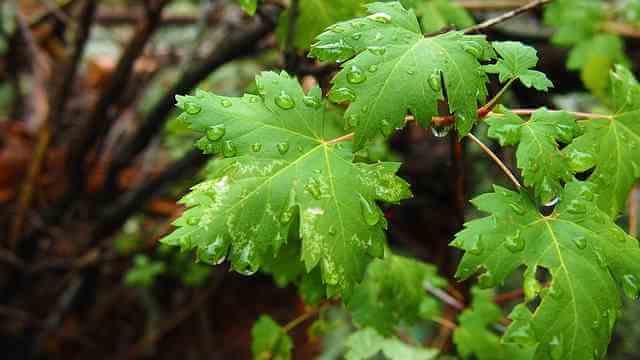
The root system is a very important part to absorb water from the soil. In higher plants water is absorbed through root hairs. Xylem cells help to conduct water in an upward movement. The water reaches the leaves through xylem cells where water helps in photosynthesis. Without water, plants cannot make their food through photosynthesis.
Soil Water
The rain is a source of soil water. Groundwater is of different forms. These all types of water is not useful for plants, only capillary water can be utilised by the plants.
Types of Water in The Soil
- Gravitational water
- Capillary water
- Hygroscopic water
- Runaway water
- Chemically combined water
- Water vapour
Plants absorb water with the help of their root hairs but in some cases water absorbed by stems and leaves also. However maximum absorption of water is done by the roots in the plants.
9. Plant Water Relations: Ascent of sap
Upward water transportation along with the dissolved minerals from roots to the aerial parts of the plant is known as the ascent of sap. the ascent of sap is also called translocation of water. The sap is water with dissolved minerals.
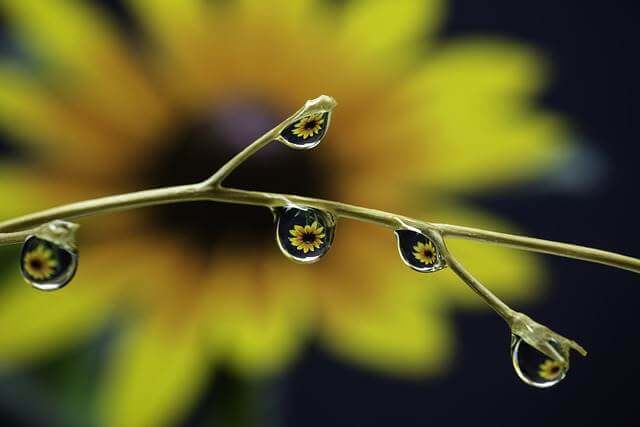
In 1936 Huber and Schmidt calculate the velocity of the ascent of sap by using radioactive 32P, specific dyes and also by heat pulse transport between two specific points of the stem.
Theories of The Ascent of Sap
The mechanism of the ascent of sap is not easy. the various theories put forward to explain the mechanism. These all theories can be placed in the following three categories
- Vital force theories
- Root pressure theory
- Physical force theories
10. Plant Water Relations: Transpiration
Transpiration is a physiological process which occurs in plants. Transpiration is the loss of water in the form of vapour from the aerial parts of a plant. The maximum transpiration reported in mesophytic plants. About 98% of water absorbed by land plants evaporates from the aerial parts diffuse into the atmosphere.
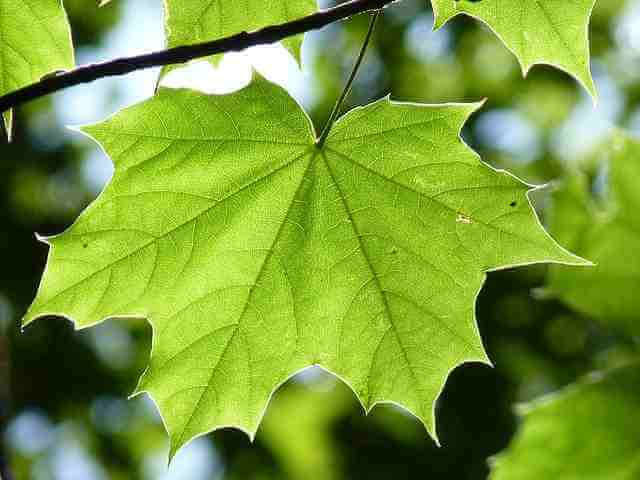
Only living cells can be involved in the process of transpiration. Transpiration is very important to keep the surface of leaves and young stem wet and protects from sun burning.
In the process of transpiration, the water moves through the epidermis with its cuticle or through the stomata.
Types of Transpiration
Transpiration through the leaves is called folier transpiration. Transpiration from the stem is called cauline transpiration.
Transpiration is mainly of four types
- Cuticle transpiration: Up to 20% of the total transpiration, takes place through cuticle transpiration in plants. Cuticle transpiration takes place with the help of the cuticle layer.
- Lenticular transpiration: There is only 0.1% of the total water loss through Lenticular transpiration. This is the loss of water vapour through lenticels.
- Stomatal transpiration: About 80 to 90% of the total water vapour loss takes place with the help of stomatal transpiration in the plants. This is the loss of water vapours through specialised pores (stomata) on the leaf surface. Stomatal transpiration is very common transpiration found in nature.
- Bark Transpiration: Transpiration occurs through the corky covering of the stem is called Bark Transpiration. The amount of Bark Transpiration is only 0.5% of the total transpiration.
Advantages of Transpiration
Disadvantages of Transpiration
Read Also
- Living Organisms: Definition, Characteristics, Types and Examples
- The Cell: History, Types, Structure, Organelles, Functions
- Ethylene: Overview, Discovery, Plant Hormones, Bioassay & Functions
- Vernalization: Site, Requirement, Process and Importance of Vernalization
- Auxins: Overview, Discovery, Types of auxins, Bioassay, Auxin Functions
Here we have discussed “Plant Water Relations: Imbibition, Diffusion, Osmosis, Absorption, Plasmolysis etc” we hope you like this article. if you have any query or suggestion, please leave a comment on the email. or contact us from contact us page.
Follow our official groups on Telegram, Whatsapp and Facebook

